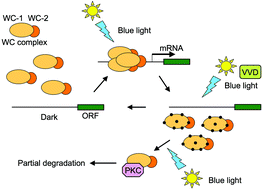Light regulates fungal development and behaviour and activates metabolic pathways. In addition, light is one of the many signals that fungi use to perceive and interact with the environment. In the ascomycete Neurospora crassa blue light is perceived by the white collar (WC) complex, a protein complex formed by WC-1 and WC-2. WC-1 is a protein with a flavin-binding domain and a zinc-finger domain, and interacts with WC-2, another zinc-finger domain protein. The WC complex operates as a photoreceptor and a transcription factor for blue-light responses in Neurospora. Proteins similar to WC-1 and WC-2 have been described in other fungi, suggesting a general role for the WC complex as a fungal receptor for blue light. The ascomycete Aspergillus nidulans uses red light perceived by a fungal phytochrome as a signal to regulate sexual and asexual development. In addition, other photoreceptors, rhodopsins and cryptochromes, have been identified in fungi, but their functional relevance has not been elucidated. The investigation of fungal light responses provides an opportunity to understand how fungi perceive the environment and to identify the mechanisms involved in the regulation by light of cellular development and metabolism.

You have access to this article
 Please wait while we load your content...
Something went wrong. Try again?
Please wait while we load your content...
Something went wrong. Try again?


 Please wait while we load your content...
Please wait while we load your content...